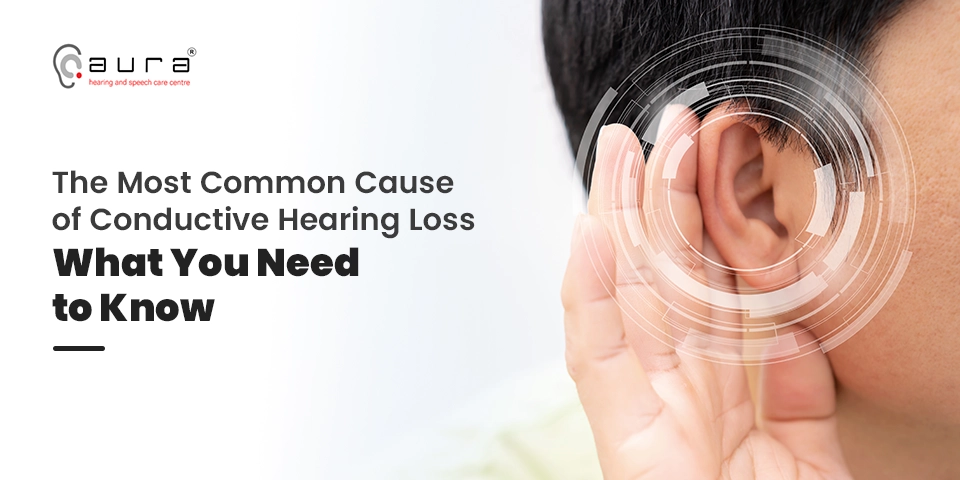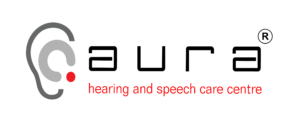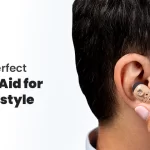
Hearing impairment is one of the most common problems affecting people worldwide. As per the recent report published by the World Health Organization in February 2025, by 2050, around 2.5 billion people are anticipated to face some degree of hearing loss, and more than 700 million will require hearing rehabilitation.
Among all the types, conductive hearing loss only accounts for a portion of all hearing loss. In this blog, we will discuss conductive hearing loss, its causes, symptoms, diagnosis, and treatment.
What Is Conductive Hearing Loss?
Conductive hearing loss occurs when there is a problem transmitting sound through the outer and middle ear. It becomes difficult to hear soft sounds. This condition occurs due to the blockage of the ear canal, a hole in the eardrum, problems in three small bones in the ear, or the disposition of fluid in the space between the eardrum and cochlea.
Once the underlying cause is recognized, this condition is treatable, and hearing can be restored to a normal level.
Some of the major causes of conductive hearing loss
Conductive hearing loss can be caused by:
- Ear Infections (caused due to various conditions)
- Hole in the eardrum
- Otosclerosis (extra bone growth in the middle ear)
- Cholesteatoma (tumor in the ear)
- Congenital hearing loss (present since birth)
- Problem in Ear Drum
- Earwax buildup
Symptoms of the conductive hearing loss
Symptoms of conductive hearing loss depend on the severity of the condition but are often associated with:
- Muffled hearing
- Sudden or steady loss of hearing
- Stuffy sensation in the ear
- Draining of the ear
- Pain or tenderness in the ear
- Difficult to hear soft sounds
Diagnosis of the conductive hearing loss
This condition is usually diagnosed with a few tests and a hearing loss checkup. Some of them are:
Otoscopy:
- This test includes a general visual inspection of the ear canal and eardrum to identify visible obstructions or abnormalities that could be causing conductive hearing loss.
Tympanometry:
- This test is done to assess the function of the middle ear. It measures the movement of the eardrum in response to air pressure changes, showing potential issues like fluid buildup or eardrum perforations.
Pure-Tone Audiometry:
- This test provides a detailed measurement of hearing sensitivity. Importantly, when combined with bone conduction testing during the audiometry exam, it can help to identify if a hearing loss is conductive. The audiogram can show an “air bone gap,” which is a key indicator of conductive hearing loss.
Treatment of conductive hearing loss:
Medications: Medications are used to treat ear infections caused by bacteria or fungus.
Earwax Removal: Thick earwax can be washed away by professional cleaning; this can improve the symptoms of hearing loss.
Surgical Intervention: Surgery is usually performed to treat the condition like otosclerosis, cholesteatoma, or a burst tympanic membrane that might affect the hearing of the ear.
Hearing Aids: Hearing aids are generally used to make sound louder and restore hearing when surgery isn’t possible. Aura Hearing Care offers a range of advanced hearing aids, including:
o Receiver In Canal (RIC): The device is compact and hidden, good for people new to hearing aids.
o Completely in the Canal (CIC): It is designed to fit completely inside your ear canal.
o Invisible in Canal (IIC): This is a minimal device, almost totally hidden, with just a tiny part to help take it out.
o In the Canal (ITC): Fits partly in the ear canal, with a small portion showing.
o In the Ear (ITE): This is a personalized hearing aid, designed to fit the outer ear for comfort.
o Behind the Ear (BTE): This device is the most used type and is available in different sizes.
Assistive Devices: Using BAHAs (Bone-Anchored Hearing Aids), which bypass the conductive pathway and send sound directly to the inner ear, can offer full amplification benefits.
Conclusion:
Conductive hearing loss happens when sound waves can’t transmit to your inner ear. This can be caused by various reasons such as earwax buildup, infection, or malformations in the ear canal. Fortunately, this condition is treatable, and hearing can be restored to normal level. So, getting a proper diagnosis on time and treatment can help treat the condition effectively.
Want to hear better? Aura Hearing Aid can help you find the right solution. Book your visit today!
What is conductive hearing loss?
Conductive hearing loss happens when sound can’t go through your outer or middle ear to your inner ear. This can be caused by earwax buildup, infections, fluid, or ear problems.
Can conductive hearing loss be treated?
Yes! You can hear better again with medicine, earwax removal, or surgery.
How do I identify if I have conductive hearing loss?
You might hear sounds like they are far away, feel like your ear is stuffed, or have trouble hearing soft sounds.
Does Aura Hearing Aid provide hearing aids for conductive hearing loss?
Yes, if medicine doesn’t fix it, Aura Hearing Aid has the best hearing aid options to make sounds clear and improve your hearing.
How can I book a consultation with Aura Hearing Aid?
You can go to our website (Types of Hearing Aids | Find the Best Fit for Your Needs) or call us to make an appointment with our hearing experts.







